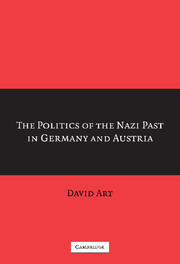Book contents
- Frontmatter
- Contents
- Preface and Acknowledgments
- The Politics of the Nazi Past in Germany and Austria
- 1 Introduction
- 2 Public Debates and Political Change
- 3 The Culture of Contrition
- 4 The Victim Culture
- 5 Combating the Far Right in Germany
- 6 Taming the Far Right in Austria?
- 7 Conclusions and Extensions
- Appendix A Coding Scheme for Die Zeit Content Analysis
- Appendix B Breakdown of Interviews Conducted
- Appendix C Coding Semistructured Interviews with German Politicians
- Appendix D Coding Semistructured Interviews with Austrian Politicians
- Appendix E Question Set – Germany
- Appendix F Question Set – Austria
- Bibliography
- Index
6 - Taming the Far Right in Austria?
Published online by Cambridge University Press: 15 December 2009
- Frontmatter
- Contents
- Preface and Acknowledgments
- The Politics of the Nazi Past in Germany and Austria
- 1 Introduction
- 2 Public Debates and Political Change
- 3 The Culture of Contrition
- 4 The Victim Culture
- 5 Combating the Far Right in Germany
- 6 Taming the Far Right in Austria?
- 7 Conclusions and Extensions
- Appendix A Coding Scheme for Die Zeit Content Analysis
- Appendix B Breakdown of Interviews Conducted
- Appendix C Coding Semistructured Interviews with German Politicians
- Appendix D Coding Semistructured Interviews with Austrian Politicians
- Appendix E Question Set – Germany
- Appendix F Question Set – Austria
- Bibliography
- Index
Summary
In October 1999, the Austrian Freedom Party (FPÖ) captured nearly 27 percent of the popular vote in national parliamentary elections. Several months later, after negotiations between the Social Democrats (SPÖ) and the People's Party (ÖVP) collapsed, the FPÖ formed a coalition government with the ÖVP. The domestic and international reactions to the formation of the Black-Blue coalition (the colors of the FPÖ and ÖVP, respectively) were dramatic. Members of the new government were forced to enter parliament through tunnels to avoid the largest political demonstration in postwar Austrian history. The fourteen other states of the European Union (EU) downgraded diplomatic relations with Austria to a technical level, an unprecedented action against another member state.
As international attention focused on Austria for the second time since the Waldheim affair, many observers asked the following question: how was it that a right-wing populist party could become so strong in a state with solid economic growth, low unemployment, and a generous welfare state? Scholars have offered three main explanations for the “Haider phenomenon.” First, the FPÖ fostered, and benefited from, popular discontent with Austria's sclerotic system of consociational democracy. Thirteen straight years of the SPÖ-ÖVP coalition had left many Austrians with the impression that their country lacked any political opposition, and the FPÖ's promises to shake up the system resonated with them. Second, the FPÖ played on xenophobic fears following a massive wave of immigration in the late 1980s and early 1990.
- Type
- Chapter
- Information
- The Politics of the Nazi Past in Germany and Austria , pp. 176 - 195Publisher: Cambridge University PressPrint publication year: 2005

